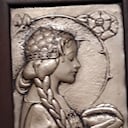What flower is the symbol of the Emperor in Japan?
Chrysanthemums first arrived in Japan by way of China in the 5th century. By the Heian Period, the flower was cultivated throughout Japan. It represented the noble class and the season of autumn, and the Japanese even had a Chrysanthemum festival. When the flower was adopted for the Imperial Seal of Japan some families also cultivated it to signal their support and good relationship with the Imperial family.
In the present day, each autumn there are chrysanthemum exhibitions at the Meiji Shrine and Yasukuni Shrine in Tokyo. The Yasukuni Shrine, formerly a state-endowed shrine has adopted the chrysanthemum crest. Culinary-grade chrysanthemums are used to decorate food, and they remain a common motif for traditional Japanese arts like porcelain, lacquerware and kimono.
Chrysanthemum growing is still practised actively as a hobby by many Japanese people who enter prize plants in contests. Chrysanthemum "dolls", often depicting fictional characters from both traditional sources like kabuki and contemporary sources like Disney, are displayed throughout the fall months, and the city of Nihonmatsu hosts the "Nihonmatsu Chrysanthemum Dolls Exhibition" every autumn in historical ruin of Nihonmatsu Castle.
In Japan, the chrysanthemum is a symbol of the Emperor and the Imperial family. In particular, a "chrysanthemum crest", i.e. a mon of chrysanthemum blossom design, indicates a link to the Emperor; there are more than 150 patterns of this design.
More Info:
en.wikipedia.org




